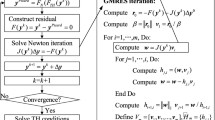Abstract
With the rapid improvement of computer performance and solving algorithms, the high-precision simulation of nuclear power plant becomes more and more practical. The main advantage of high-precision simulation is that it can improve the prediction range of safety parameters and identify the main influencing parameters. This involves the research of many physical processes, including the solution of complex problems of thermal hydraulics with other disciplines or different fields (such as primary system and containment). The coupling program can be used as a favorable method for nuclear reactor core safety analysis, and it can simulate and predict the behavior of nuclear power plant more accurately and in detail, thus further improving the safety and economy of nuclear power plants. The interaction between neutron dynamics and thermal hydraulics is very important for safety analysis and accurate prediction of local parameters. The coupled analysis program of hydraulics and containment can reasonably simulate the response of reactor system and containment in LOCA at the same time. Most coupled programs are developed by integrating an independent program in the most appropriate way. The main purpose of this development model is to provide a more realistic description of key phenomena for reactor design and safety, thus reducing conservatism introduced in the traditional program calculation process. Coupling program must consider coupling method (integration algorithm or parallel process, internal or external coupling), spatial map** scheme and time synchronization algorithm. The coupling program can be based on a modern and user-friendly simulation platform, such as GENUS. It has powerful functions of preprocessor and post-processor, and can easily realize the coupling of multiple programs according to the specific needs of users. In this paper, the present situation of coupling thermal hydraulics with three-dimensional neutron physics, containment program and other system programs is introduced, and the coupling schemes, simulation platforms and applications of different programs are discussed.
Access this chapter
Tax calculation will be finalised at checkout
Purchases are for personal use only
Similar content being viewed by others
References
Davies, S., Litskevich, D., Rohde, U., Detkina, A., Merk, B., Bryce, P., Levers, A., Viswa, M., Ravindra, V.: DYN3D and CTF coupling within a multiscale and multiphysics software development (Part I). Energies (2021). http://doi.org/10.3390/en14165060
Calleja, M., Sanchez, V., Jimenez, J., Imke, U., Stieglitz, R., Macián, R.: Coupling of COBAYA3/SUBCHANFLOW inside the NURESIM platform and validation using selected benchmarks. Ann. Nucl. Energy 71, 145–158 (2014). ISSN 0306-4549. http://doi.org/10.1016/j.anucene.2014.03.036
Younan, S., Novog, D.R.: Development and testing of TRACE/PARCS ECI capability for modelling CANDU reactors with reactor regulating system response. Sci. Technol. Nucl. Installations 2022. http://doi.org/10.1155/2022/7500629
Aumiller, D.L., Tomlinson, E.T., Bauer, R.C.: A coupled RELAP5-3D/CFD methodology with a proof-of-principle calculation. Nucl. Eng. Des. 205(1–2), 83–90 (2001). ISSN 0029-5493. http://doi.org/10.1016/S0029-5493(00)00370-8
Palazzi, A., Bluck, M., Lo, S., Slijepčević, S.: Coupling RELAP5-3D and STAR-CCM+ for simulations of steady and transient single phase flows. In: International Congress on Advancements in Nuclear Power Plants, San Francisco, CA (2016)
Forestier, M., Girault, G., Jacq, F., Sargeni, A.: Antares: coupling Parcs with Cathare-3. In: Conference: PHYSOR 2020: Transition to a Scalable Nuclear Future, Cambridge, United Kingdom, March 29th–April 2nd 2020 (2020)
Knepper, P.L., Hochreiter, L.E., Ivanov, K.N., Feltus, M.A.: Coupling of TRAC-PF1/MOD2, Version 5.4.25, with NESTLE. United States (1999)
Attavino, A., Cerroni, D., Cervone, A., Fancellu, L., Manservisi, S.: FEMLCORE–CATHARE coupling on SALOME platform. Reports, Monday 14th September (2015)
MOOSE Simulation Environment: https://moose.inl.gov/SitePages/Home.aspx
Author information
Authors and Affiliations
Corresponding author
Editor information
Editors and Affiliations
Rights and permissions
Copyright information
© 2023 The Author(s), under exclusive license to Springer Nature Singapore Pte Ltd.
About this paper
Cite this paper
Zhou, S. et al. (2023). Research on Interface Technology of Coupling Thermal-Hydraulics and Other Codes. In: Liu, C. (eds) Proceedings of the 23rd Pacific Basin Nuclear Conference, Volume 3. Springer Proceedings in Physics, vol 285. Springer, Singapore. https://doi.org/10.1007/978-981-19-8899-8_77
Download citation
DOI: https://doi.org/10.1007/978-981-19-8899-8_77
Published:
Publisher Name: Springer, Singapore
Print ISBN: 978-981-19-8898-1
Online ISBN: 978-981-19-8899-8
eBook Packages: Physics and AstronomyPhysics and Astronomy (R0)




